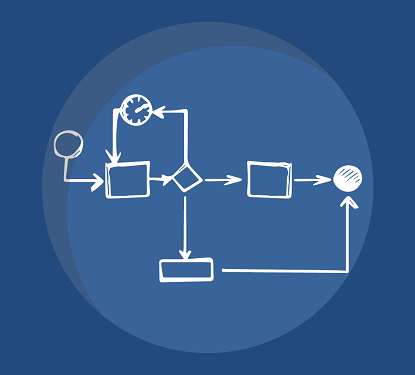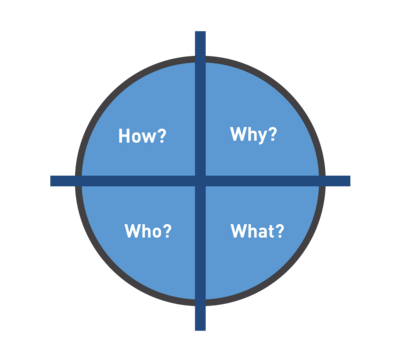08/15/2024 - Articles
How to define project goals? Methods and tips
Successful projects start with clear and precise objectives. But where can you find the best sources for defining high-quality project objectives? We will guide you to six productive sources against aimlessness. Discover proven methods such as the Magic Triangle, the Devil’s Quadrangle and the Target Cross, and find out how the SMART method can take your goal definition to the next level.
Where can you find project goals? 6 productive sources against aimlessness
Clearly defined project objectives form the backbone of successful projects. As a responsible project manager, it is up to you to define these project objectives. The following six strategic sources will give you precise insights into how you can find high-quality raw material for your project goal definition - be it through the initiation of the project, the consideration of customer requirements or the integration of overarching corporate goals.
Strategic source 1: The project idea
In internal software development projects, the process often starts with a loose idea such as “What if we develop a platform for automated error detection in software?”. The overarching project goal is then derived through repeated considerations and improvements. Although the initial idea may still be vague, the fundamental focus of the project is already identified at this early stage.
Strategic source 2: Customer requirements
Project requirements are often defined at an early stage. Following on from the previous example, the client or the person who developed the project idea may already have specific requirements or constraints in mind, from which clear objectives can be derived:
- The software development must not take longer than six months and must stay within a certain budget.
- The website must be fully functional by the start of the marketing campaign.
Strategic source 3: Integration of corporate objectives
It is crucial to take corporate objectives into account when designing projects, even if they are not explicitly stated. After all, project objectives should always contribute to the corporate objectives. However, an explicit mention is necessary if the corporate objective is important for the project and concrete measures are required to achieve the objective.
Examples of how project objectives can be derived from corporate objectives, even if they have only been roughly formulated so far, could be as follows:
| Corporate objective | Derived project objective |
|---|---|
|
|
Strategic source 4: Project environment
Eliminate uncertainties by analyzing the project environment in detail. The term “project environment” refers to a wide range of factual and social as well as internal and external factors that are identified as part of an environment analysis. These factors and influences must be carefully considered in the project.
The following table shows examples of how objectives can be derived from various factors in the project environment:
| Environment factor | Derived project objective |
|---|---|
|
|
Strategic source 5: Risk analysis as a trailblazer
It is possible that risks not only represent challenges, but can also serve as a source of inspiration for goals. In a software project, for example, it could be recognized during the risk analysis that the resulting system could be rejected by end users.
The following goal could be derived from this: To develop a user-friendly interface that enables users to operate the system independently and safely after a short training session.
Here is a table with further examples:
| Risk | Derived project objective |
|---|---|
|
|
Strategic source 6: Stakeholder analysis as a success factor
Deepen your knowledge of the interests and goals of the stakeholders. If the stakeholder analysis shows that certain objectives or interest groups are very important, you can formulate project objectives that are complementary to the interests of this target group.
This is because during the stakeholder analysis, not only their interests but also their individual goals are examined more closely. These individual goals can easily become concrete project goals, especially if the stakeholder in question is considered to be particularly important for the project.
- Customer as stakeholder: An individual goal of the customer could be to obtain a user-friendly software solution. This goal can become a project goal by prioritizing the development of an intuitive user interface.
- Finance department as a stakeholder: If the finance department is categorized as a significant stakeholder, their goals, such as budget control, can become an explicit project goal.
- Team members as stakeholders: Team members' individual goals, such as professional development or knowledge enhancement, can be integrated into project goals to boost their motivation and productivity.
In these examples, the individual goals of stakeholders are transformed into project goals to ensure targeted fulfillment of their needs and strengthen stakeholder engagement.
Define project goals: Methods
Once you have exhausted the sources of project objectives, you will hopefully have a whole list of possible objectives. However, these objectives are not yet suitable as project objectives.
Simply SMART - key role in defining objectives in project management
The precise formulation of project goals forms the foundation for project success. A proven and effective approach for this is the SMART method. This aims to define objectives in a way that ensures they are clear and achievable.
The SMART criteria stipulate that objectives should be specific, measurable, achievable, realistic and time-bound. These criteria are particularly important if rough objectives already exist and now need to be worked out in more detail. The acronym SMART stands for:
Specific: A clear and detailed description of the objective enables a clear understanding throughout the team.
Measurable: The ability to assess objectives both qualitatively and quantitatively creates an objective basis for the success of the project.
Executable: Goals should be appropriate and attractive to all stakeholders to encourage shared commitment.
Realistic: Setting realistic goals ensures that they are achievable within the given timeframe and with the available resources.
Timed: Setting a timeframe for a goal provides a clear roadmap for implementation and contributes to the efficiency of the project.
The clear definition of objectives according to the SMART formula not only makes communication within the project team much easier, but also prevents misunderstandings. This proven method promotes precise project alignment and is an indispensable tool for every project manager.
Formulating SMART project goals - making success measurable
For more in-depth insights and instructions on how to apply the SMART method, we recommend our comprehensive article on SMART goals in our blog. This provides further information and practical tips on how to successfully implement this concept.
SMART alternatives: PURE, CLEAR and AMORE
It is important to emphasize that SMART is not the only criterion for optimally formulated goals. Other criteria can often be helpful to further specify the goal definition. There are a few other formulas that can be used to help with this:
- PURE: Positively formulated, Understood, Realistic and Ethical. A positive formulation is generally recommended in order to generate the desired positive reaction in the brain.
- CLEAR: Challenging, Legal, Exciting, Agreed and Recorded.
- AMORE: Ambitious, Motivating, Organized, Realistic, Earnest
Simply magical - the magic triangle in project management
The Magic Triangle in project management is a helpful method for defining project goals based on three central goal dimensions: Time, Cost and Performance. These dimensions can serve as a point of reference for developing clear objectives. In many projects, time, cost and performance targets play an essential role in the development of objectives.
The Magic Triangle enables simple and effective goal setting, especially at the beginning of projects. The project objective comprises the achievement of a desired state (performance objective) within a specified end date (time objective or deadline objective), taking into account a certain use of resources (resource objective or cost objective).
By considering these three parameters - time, costs and performance - project goals can be precisely formulated. The magic triangle thus offers a simple yet structured approach to taking the key aspects of a project into account and clearly defining the objectives.
Examples:
1. Time target
Vague wording: “The project should be completed quickly.”
Precise time target: “The project is to be completed by May 31 in order to meet the specified time frame.”
2. Cost target
Vague wording: “The project budget should be limited.”
Precise cost target: “The project budget is limited to 100,000 euros in order to make optimum use of financial resources.”
3. Performance target
Vague wording: “The project should improve customer satisfaction.”
Precise performance target: “Customer satisfaction has been increased by at least 20% by implementing a more user-friendly interface.”
4. Performance and time target
Vague wording: “The project should contain innovative functions.”
Precise performance and time target: “Innovative features, including AI integration, are implemented on December 1 to gain an early competitive advantage.”
5. Performance, time and cost target
Vague wording: “The project should increase internal efficiency.”
Precise performance, time and cost target: “The implementation of a new xy process will be completed on April 1 and the total costs will be less than 80,000 euros.”
These examples illustrate how you can formulate clear, measurable and precise project goals through the integration of time, costs and performance, enabling clear alignment and evaluation.
Simply diabolical - the Devil’s Quadrangle in project management
The Devil’s Quadrangle, developed by Harry Sneed, extends the concept of the Magic Triangle in project management. It splits the target variable “performance” into content and quality, resulting in four target variables. Changes in one of these target variables have an impact on the others. It represents the four central variables of a project: Cost, time, content (functionality) and quality. These variables are shown on the diagonals of a square, with the bad values (e.g. high costs or low quality) on the outside and the good values on the inside.
At the start of a project, these four variables form a square, the area of which represents the productivity or efficiency of the project. If one of these values is changed, for example due to the desire for additional functions, this has a direct impact on the other values. The area of the square - i.e. the efficiency - remains constant. The more of the remaining variables remain unchanged, the less scope management has to make adjustments.
The model is useful for illustrating the effects of decisions in project management. For example, it can help to discuss the consequences of budget cuts with management or to discuss alternatives with a customer in order to complete a project earlier.
The idea that the area of the square remains constant makes it clear that any improvement in one area inevitably requires compromises in other areas. Even measures to increase efficiency, such as increasing motivation or using productivity tools, usually cost time and money, which means that the total area remains unchanged.
Splitting the performance dimension into content (what?) and quality (how well?) provides a further factor according to which targets can be specified and made more precise.
Simply accurate - the target cross
The target cross is particularly suitable for use in workshops at the start of a project, when many ideas are still vague and require clarification. You can systematically go through the four components of the target cross with your team to create clarity. The four components are:
Target cross question 1: Why at all? Meaning and purpose
Clarify the basic motivation behind your project. Why is it important for you and for the client? How will it benefit your company and the client? Answer these questions to inspire your team members.
Target cross question 2: What do we want to achieve? The concrete result
Leave no room for ambiguity. Clearly define what you want to achieve at the end of the project. The more concrete, the better - this is the only way to effectively monitor your goal. What should the product be at the end of the project? What is the expected project result? What is to be delivered?
Target cross question 3: Who is involved? Look at stakeholders
Carry out an initial, superficial stakeholder analysis. Identify key people and those involved. What interests need to be taken into account? Who is affected by the project? Who benefits, who is a potential opponent?
Target cross question 4: How do we measure success? Focus on measurement criteria
This aspect is directly related to the result. It is about the quantitative evaluation of “how well”. Hard measurement criteria are defined to measure the success of the project.
Create clarity: Your target cross in action
The clear definition of objectives is a decisive success factor in project management. The target cross is your concise and effective tool for structuring project ideas and converting them into precise project objectives. This method is particularly suitable for bringing structure to vague ideas and lots of information at an early stage, bringing team members up to the same level or clearly communicating the most important project conditions.
The target cross is not only a stand-alone method, but can also serve as the perfect basis for SMART goals. In a workshop, you and the client, project manager and team members fill in all areas of the goal cross and convert them into SMART project goals.
Conclusion: Precise project objectives - methods and sources
The tried and tested methods for defining project objectives provide a clear guide for project managers. From the use of various sources to the application of specific techniques such as SMART, the Magic Triangle or the Devil's Square, these approaches enable precise and successful goal formulation. See the methods presented here as suggestions and give them a try!

About the author
Like all other departments at Projektron GmbH, Marketing places great importance on the clear definition and tracking of project goals. After project completion, the effort is evaluated in detail, learnings are recorded and processes are continuously optimized. Kai Sulkowski is an editor in the marketing department and is always informed about current developments and best practices in project management.
More interesting articles in the Projektron blog

Efficiency vs. effectiveness
What should you do if your project manager demands that you work more efficiently? Work more or deliver better results? We explain the difference using practical examples and provide tips for effective and efficient project work.

Process modeling with BPMN
BPMN - the standard for process modeling. BPMN stands for Business Process Model and Notation and is an international modeling language for business processes. You can find out everything about BPMN and how you can use it here.

Digital working time recording
Since the ruling of the Federal Labor Court (BAG) in September 2022, it has been clear that every employer is obliged to systematically record employees' working hours. Find out what you should look out for when choosing software for digital working time recording.

Resource planning
Resource planning is a strategically important step in project management. What is a resource plan? What information does it contain? What are the benefits of resource planning in project management? Here's resource planning from A to Z.














